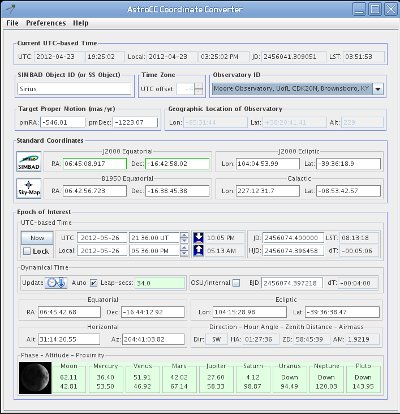AstroCC
Coordinate Converter for Astronomy

AstroCC is written in Java and ...
- Runs on Windows, Mac, and Linux
- Accesses SIMBAD
- Provides ephemerides for the Moon and major planets
- Provides Julian and barycentric dates and times
AstroCC is a coordinate conversion utility for astronomy. It accepts an object
designation or the coordinates of an object and calculates coordinates in alternative
systems, and at different dates, times, and locations. It also provides lunar and bright
planet coordinates to aid in planning observations.
The legacy release of the independent AstroCC has been
superceded by the version incorporated within AstroImageJ.
Authors: Karen Collins (Harvard Center for Astrohysics and John Kielkopf (University of Louisville).
Availability: AstroCC is open source software and is distributed under the terms of the GNU General
Public License. See AstroImageJ for the current version.
Credits: Parts of
AstroCC are based on XmTel, WCSTools, Nuvola icons, and ImageJ open source software
packages. Solar system object coordinate calculations and internal HJD/BJD calculations
are based on code adapted from JSkyCalc which was written by John Thorstensen of
Dartmouth College. BJD values may also be retrieved from
http://astroutils.astronomy.ohio-state.edu/time/utc2bjd.html
which is based on Eastman et
al. 2010. Coordinate data are obtained from SIMBAD. Leap second data is obtained from the
U.S. Naval Observatory at
http://maia.usno.navy.mil/ser7/tai-utc.dat.
The observatory
data were compiled from the ESO website at
http://www.eso.org/~ndelmott/obs_sites.htm
which credits the U.S. Naval Observatory and the H.M. Nautical Almanac Office. The lunar
phase images are adapted from Lunar_libration_with_phase_Oct_2007.gif from Wikimedia
Commons (submitted by Tom Ruen). We gratefully acknowledge contributions from
Cheolha (Pedro) Lee of Ball Aerospace.

Last update: February 29, 2024
kielkopf at louisville dot edu


